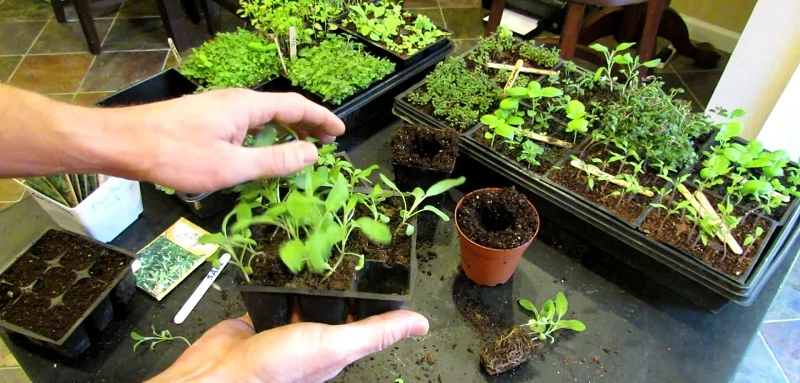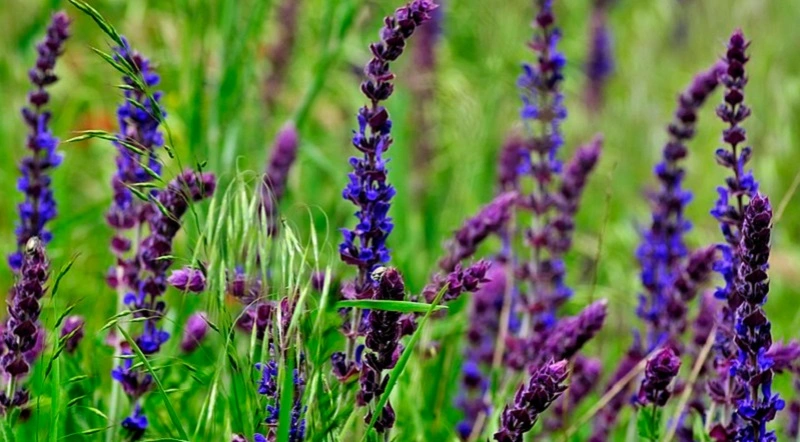Sage is a healing herb that will surprise you with its variety of healing properties and range of uses.
Sacred herb, elixir of longevity, sage or sage are all names of one plant. The healing properties of sage were known to the ancient Egyptians. But the plant came to us from the Mediterranean. Salvia mentions Hippocrates in his treatises on healing, calling her a “savior of life.”
Sage is a semi-shrub with numerous quadrangular deciduous stems. There are more than 700 species of this plant in the world, but only two are used for medicinal purposes: Muscat sage and Medicinal sage (Salvia officinalis).
Medicinal raw materials in sage are the leaves and tops of plants with flowers. In the inflorescences and leaves of sage found 0.3-0.5% of essential oil, which contains linalool, acetic acid, aromatic resins, pinene, formic acid, flavonoids and tannins. Medicinal sage seeds contain about 20% protein and 30% fatty oil, which dries quickly, and sage roots contain coumarin.
Medicinal properties of sage
The plants have pronounced anti-inflammatory, antimicrobial, hemostatic, tonic properties, as well as sage can increase the secretory activity of the gastrointestinal tract, increase the secretion of gastric juice and reduce sweating.
Medicinal properties of this sage have led to its use in the treatment of liver disease, kidney disease, various viral infections. Sage is also well suited for the treatment of sore throat, bronchitis, mumps, gingivitis, radiculitis, polyarthritis, neuritis, diabetes, gynecological and skin diseases, wounds, ulcers, boils, burns, asthma and more. This list could go on and on.
In folk sage use medicine:
- In the fight against lung diseases, including those as severe as tuberculosis.
- Due to its mild diuretic and disinfectant effect, sage is used in inflammation of the urinary tract – pyelonephritis, cystitis.
- The high content of phytohormones makes sage a good medicine for the treatment of diseases of the female genital area. It is prescribed for severe manifestations of menopause (hot flashes, nervousness, sweating), infertility (estrogen deficiency).
- Due to the hemostatic effect, it is used during prolonged and heavy menstruation.
- Sage is part of the chest fees, which are used to relieve cough with bronchitis, pneumonia.
- Gastric fees with this plant help with bloating, have choleretic properties, stimulate appetite and peristalsis of all parts of the digestive tract.
- Externally, sage is used for fungal skin lesions, purulent wounds, psoriasis, burns, frostbite.
- Sedentary baths based on a decoction of this plant reduce inflammation and bleeding from hemorrhoids.
- Sage is a good stimulant of immunity, in addition, it improves memory, enhances attention and increases efficiency.
In cosmetology, sage has also found application:
- Sage essential oil is mainly used for aromatherapy. It is used as a stress reliever, soothes headaches, brings balance and satisfaction.
- Sage decoction rinses hair, it gives them shine, gets rid of dandruff and greasy shine, stimulates their growth.
- Antibacterial properties make this plant an indispensable helper in the treatment of juvenile acne.
- Sage extract is included in many products for the care of young skin prone to oiliness.
- A compress of sage decoction on the eye area will help get rid of dark circles and make the look radiant.
- Sage essential oil is used in the preparation of fragrances in perfumery. In addition, it has the ability to fix other essential oils that are easily destroyed, which allows you to create sustainable perfumes, eau de toilette and cologne.
Sage is also used in cooking as a seasoning for meat and sauces, as a base for teas, infusions, vermouth and more. But because of the strong aroma and taste it should be done with caution.
Growing sage at home
Sage is also an unpretentious perennial, ornamental plant that can be grown at home.
Salvia grows best in loose or neutrally slightly acidic soils, so you can safely buy a substrate for houseplants in any store. Just pay attention to the pH level on the label, it should be no more than 7. The pot for growing should be selected large enough. The most optimal capacity will be 10-15 liters. This is due to the structure of the root system of the plant, which requires space.
You will also need small pebbles or expanded clay to ensure good drainage. If you do not have the opportunity to immediately plant sage in a large pot, you can use the available at first, but as soon as the bush grows, it is better to transplant it. This is done by transshipment, trying not to damage the roots, in autumn or spring.

Sage can be grown at home vegetatively (cuttings) or by seed. In the first case – you need to cut a twig 10 cm long. Remove all small leaves and shoots. Put the stem almost completely in the water and wait.
In two weeks the roots will appear (2-3 cm) and you will be able to plant the plant in the soil. In the second option – choose quality, almost black seeds 3 mm wide. The seeds can not be pre-processed, but can be soaked or kept in the refrigerator for 24 hours. Next, place them 2-3 mm in loose, rich, pre-moistened soil. Provide a temperature of + 20-25 ° C and good lighting; water regularly but sparingly. In 2-4 weeks the seeds will germinate.
Since sage loves light and heat, the best time to sow it is late spring.
Sage loves moisture, it should be sprayed often and make sure that the substrate is moist (abundant, but rarely watered). Soft water is optional.
Once a month, put the plant in the shower. Do not overdo it, with excessive watering the plant will grow with a less pronounced aroma or, in the worst case, it will lose its roots.
In the first year of cultivation, this spicy herb can be harvested in September, after the plant has bloomed. Cut off only the lower leaves. In the second year and subsequent leaves should be cut off no more than 2-3 times from the beginning of the flowering period until late autumn. Sage leaves can be used both fresh and dried. The leaves are dried in a warm dry dark place or in an oven at a temperature not exceeding +50 degrees. Store dried sage in glass jars with lids.

